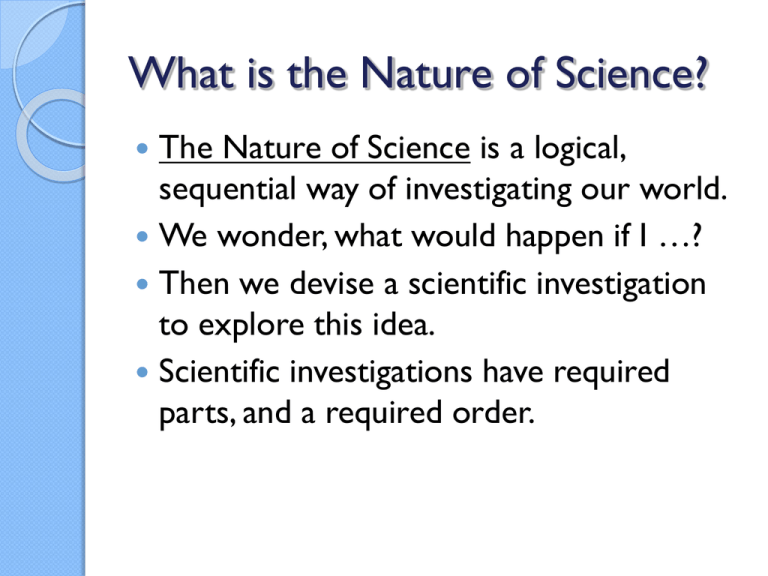Parts of a scientific investigation
advertisement

What is the Nature of Science?
The Nature of Science is a logical,
sequential way of investigating our world.
We wonder, what would happen if I …?
Then we devise a scientific investigation
to explore this idea.
Scientific investigations have required
parts, and a required order.
Variables
Variables are the components that change in a
scientific investigation. The components must
be measurable. There are 2 types of variables:
◦ The independent variable is the component that the
investigator changes. It is graphed on the x axis.
There is only 1 independent variable.
◦ The dependent variable is the component that
changes due to the independent variable. It is graphed
on the y axis. There is only 1 dependent variable.
Constants
In a valid scientific investigation, we
change 1 variable (independent) and
measure the effect on 1 other variable
(dependent).
All other components must remain the
same!
Components that don’t change in a
scientific investigation are called constants.
Constants - 2
For example, we might investigate how amount
of sunshine affects plant growth.
We would change the daily amount of sunshine
(independent variable) and measure the amount
of plant growth (dependent variable).
What would some constants be?
Amount of water, type of plant, type of soil,
temperature of the environment, etc – all must
stay the same!
Control
But we would also need to know if
sunshine affects plant growth at all, so we
need a control – in which we measure the
dependent variable when the independent
variable = 0.
For this experiment, the control would be
the amount of growth for a plant with no
daily sunshine.
Hypothesis
A hypothesis is a statement that links
the independent to the dependent
variable.
It is often written in this form: If the
independent variable does this, then the
dependent variable will do this.
Hypothesis - 2
For our earlier experiment (amount of
sunshine and plant growth), an acceptable
hypothesis would be:
If the amount of sunshine increases, the
amount of plant growth will increase.
Hypothesis - 3
What would be another valid hypothesis?
If the amount of sunshine increases, the
amount of plant growth will decrease.
Or
If the amount of sunshine increases, the
amount of plant growth will remain
unchanged.
Hypothesis - 4
2 purposes for a hypothesis:
◦ To get you thinking about the experiment
◦ To get you invested in the outcome
A hypothesis is NOT judged on
correctness – it is unacceptable to go
back and change your hypothesis to
reflect what actually happened!
Data
Data is collected through observation –
using 1 or more of the 5 senses.
Examples of observation:
◦ seeing the volume in a graduated
cylinder
◦ smelling the sulfur odor from a chemical
◦ hearing the tick of the metronome, etc.
Analysis
Anything done to the data is analysis.
Analysis includes:
◦ graphing
◦ identifying trends
◦ making calculations
◦ estimating amount and types of error,
etc.
Graphing
Types of graphs and common uses:
A circle graph is for percentages.
A bar graph is for data that occurs in
categories (grades, months, m/f, etc) –
called “discrete” data.
A line graph is for continuous data.
Graphing - 2
A correct line graph has:
a relevant title,
each axis is labeled including units,
each axis has a consistent scale,
points are plotted,
a line or curve of best fit is drawn (going thru as
many points as possible, and with as many
points above the line as below)
Graphing - 3
If the data points appear to be linear, graph it as
a line of best fit.
If the data points appear to be curved, graph it
as a smooth curve of best fit.
Since we are looking for trends or patterns,
very rarely do we “connect the dots” when
graphing in science!
Identifying trends
Trends are either:
◦ Direct relationship – when one value increases
the other value also increases
or
or a line with a positive slope
◦ Inverse relationship – when one value increases
the other value decreases
or a line with a negative slope
• No relationship – either too varied to be
determined, or remains constant (a line with 0
slope)
Making calculations
Suppose your task is to find the density of
an object. Your lab equipment can measure
mass and volume. You can calculate density
as mass/volume. Mass and volume are data,
the calculation for density is analysis (since
you didn’t directly observe it).
Often we graph linear data and calculate the
slope of the line.
Slope = (y2 – y1)/(x2 – x1)
Making calculations - 2
What is the slope of this line?
Making calculations - 3
The equation for a line is y = mx + b
m is the slope, and b is the y-intercept.
What would be the equation for the
previous graph?
y = (.00625 kgm-2/mm)x + .13kgm-2
What is y measuring?
What is x measuring?
Cucumber yield = (.00625 kgm-2/mm)precipitation + .13kgm-2
Estimating Error
Measurement errors can be categorized
as 2 types:
1. Random – caused by the person making
the measurement. Random errors can be
reduced by repeating the measurement
and taking the average.
2. Systematic – caused by the system or
equipment used to make the
measurement.
Estimating Error - 2
Ways we will calculate:
% error is used when comparing an
experimental value to a known, standard
theoretical value (such as atomic mass,
acceleration due to gravity):
◦ % error = (|theo – exp| / theo) x 100
% difference is used when comparing 2
experimental values:
◦ % diff ={|val 1 – val 2| / [1/2 (val 1 + val 2)]} x 100
Handout: Calculating uncertainties for IB
Estimating Error - 3
You found carbon’s mass to be 11.5 amu.
Your textbook lists it as 12.0 amu. What
is the % error?
4.2 %
You measured an object’s mass as 25.7 g
and your lab partner measured it as 26.9 g.
What is the % difference?
4.6 %
Human Error Activity
6 stations each with a designated task
Perform each task, record your results
For each station, calculate % difference
between your value and Mrs. G’s value
Calculate an overall average of your
differences
Don’t turn it in yet! Be ready to share!







